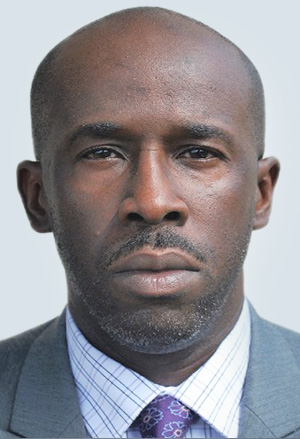

 Artificial Intelligence has the potential to bring immense opportunities, but it also poses challenges. Artificial intelligence (AI) is dominating the R&D agenda of the leading Internet industry. The Silicon Valley and other startup hubs are buzzing about artificial intelligence and the issue has come at the top of policymakers' agenda including the G20, the ITU, and the OECD, where leaders gathered this week in Paris.
Artificial Intelligence has the potential to bring immense opportunities, but it also poses challenges. Artificial intelligence (AI) is dominating the R&D agenda of the leading Internet industry. The Silicon Valley and other startup hubs are buzzing about artificial intelligence and the issue has come at the top of policymakers' agenda including the G20, the ITU, and the OECD, where leaders gathered this week in Paris.
 In modern society, there is one fact that is unquestionable: The hyper-connectivity of the digital economy is inescapable. A financial institution without an online presence or omni-channel strategy will cease to be competitive. Universities (for-profit or non-profit) must develop and continuously evolve their online learning capabilities if they are to stay relevant. Online retailers are quickly outpacing and rendering their 'brick-and-mortar' counterparts irrelevant.
In modern society, there is one fact that is unquestionable: The hyper-connectivity of the digital economy is inescapable. A financial institution without an online presence or omni-channel strategy will cease to be competitive. Universities (for-profit or non-profit) must develop and continuously evolve their online learning capabilities if they are to stay relevant. Online retailers are quickly outpacing and rendering their 'brick-and-mortar' counterparts irrelevant.
Harvard Business Review just ran an interesting article on the information security aspects of Internet of Things (IoT). Based on the storyline, the smart city initiatives are doomed to fail unless the security of the IoT devices and the systems will be improved. While security of the digital society is obviously a key concern, I am not entirely convinced that relying on the security of individual devices and systems is the best course of action.
One thing was clear from a recent presentation by the new leaders of the SF-Bay Internet Society (ISOC) Chapter Working Groups: inclusion and collaboration will be the key to these groups' success. As Dr. Brandie Nonnecke, the Internet Governance Working Group (WG) Chair said, "We haven't yet cracked the code on what 'multistakeholder' means." But that won't stop her and Dr. Jaclyn Kerr, the Data Protection, Privacy, and Security WG Chair, from trying.
As digital transformation has been picking up momentum, leading analysts such as 451 Research have suggested that hybrid multi-clouds and automated DevOps will become key constituents powering enterprises in the new era. At the heart of these enabling technologies lies Lifecycle Service Orchestration (LSO) designed for near-autonomous application deployment across hybrid infrastructures consisting of traditional on-premise data centers and public clouds.
 Today, we are in a way naturally connected to automation and robotics. In the industrial revolution, people realized that many tasks could be performed better and more efficiently by a machine. The rise of our dependence on technology has greatly risen since then, and thanks to scientific and technological advancements, we are on the breach of a new era.
Today, we are in a way naturally connected to automation and robotics. In the industrial revolution, people realized that many tasks could be performed better and more efficiently by a machine. The rise of our dependence on technology has greatly risen since then, and thanks to scientific and technological advancements, we are on the breach of a new era.
 Ever since I published an essay exploring the relationship between climate change and the Internet, I have endeavored to bring this subject to the fore as often as possible (and in relevant fora and discussions) since the responsibility of creating a more sustainable world falls on all communities and stakeholder groups. It is particularly pressing now -- at a time when international interest in curbing climate change is strengthening, while it is juxtaposed with the receding commitments of the United States government...
Ever since I published an essay exploring the relationship between climate change and the Internet, I have endeavored to bring this subject to the fore as often as possible (and in relevant fora and discussions) since the responsibility of creating a more sustainable world falls on all communities and stakeholder groups. It is particularly pressing now -- at a time when international interest in curbing climate change is strengthening, while it is juxtaposed with the receding commitments of the United States government...
When farms are connected to the Internet, we all benefit. Agriculture that gains real-time information about plants, soil, atmosphere, and irrigation, dubbed "precision agriculture", can save farmers 20-30% of their water consumption while increasing productivity by 20-70%, according to Valley Vision. The San Francisco-Bay Area Internet Society Chapter is pleased to announce that we have started phase one of our collaborative project, "Bridging California's Rural/Urban Digital Divide with Mobile Broadband"...
 Today, one of the world's largest Internet companies, Alibaba, together with a compelling array of other providers, vendors, and government bodies for the first time called for a visionary multilateral technical and operational "framework for a Blockchain of Things." The exceptionally thorough and comprehensive 23-page document, SG20-C.008, was submitted into the upcoming ITU-T SG20 Internet of Things (IoT) Study Group meeting at Dubai, 13j23 March -- the first group gathering in the organization's new 2017-2020 study period.
Today, one of the world's largest Internet companies, Alibaba, together with a compelling array of other providers, vendors, and government bodies for the first time called for a visionary multilateral technical and operational "framework for a Blockchain of Things." The exceptionally thorough and comprehensive 23-page document, SG20-C.008, was submitted into the upcoming ITU-T SG20 Internet of Things (IoT) Study Group meeting at Dubai, 13j23 March -- the first group gathering in the organization's new 2017-2020 study period.
 5G sounds like the successor to 4G cellular telephony, and indeed that is the intent. While the progression from 2G to 3G, to 4G and now 5G seems simple, the story is more nuanced. At CES last month I had a chance to learn more about 5G (not to be confused with the 5Ghz WiFi) as well as another standard, ATSC 3.0 which is supposed to be the next standard for broadcast TV.
5G sounds like the successor to 4G cellular telephony, and indeed that is the intent. While the progression from 2G to 3G, to 4G and now 5G seems simple, the story is more nuanced. At CES last month I had a chance to learn more about 5G (not to be confused with the 5Ghz WiFi) as well as another standard, ATSC 3.0 which is supposed to be the next standard for broadcast TV.